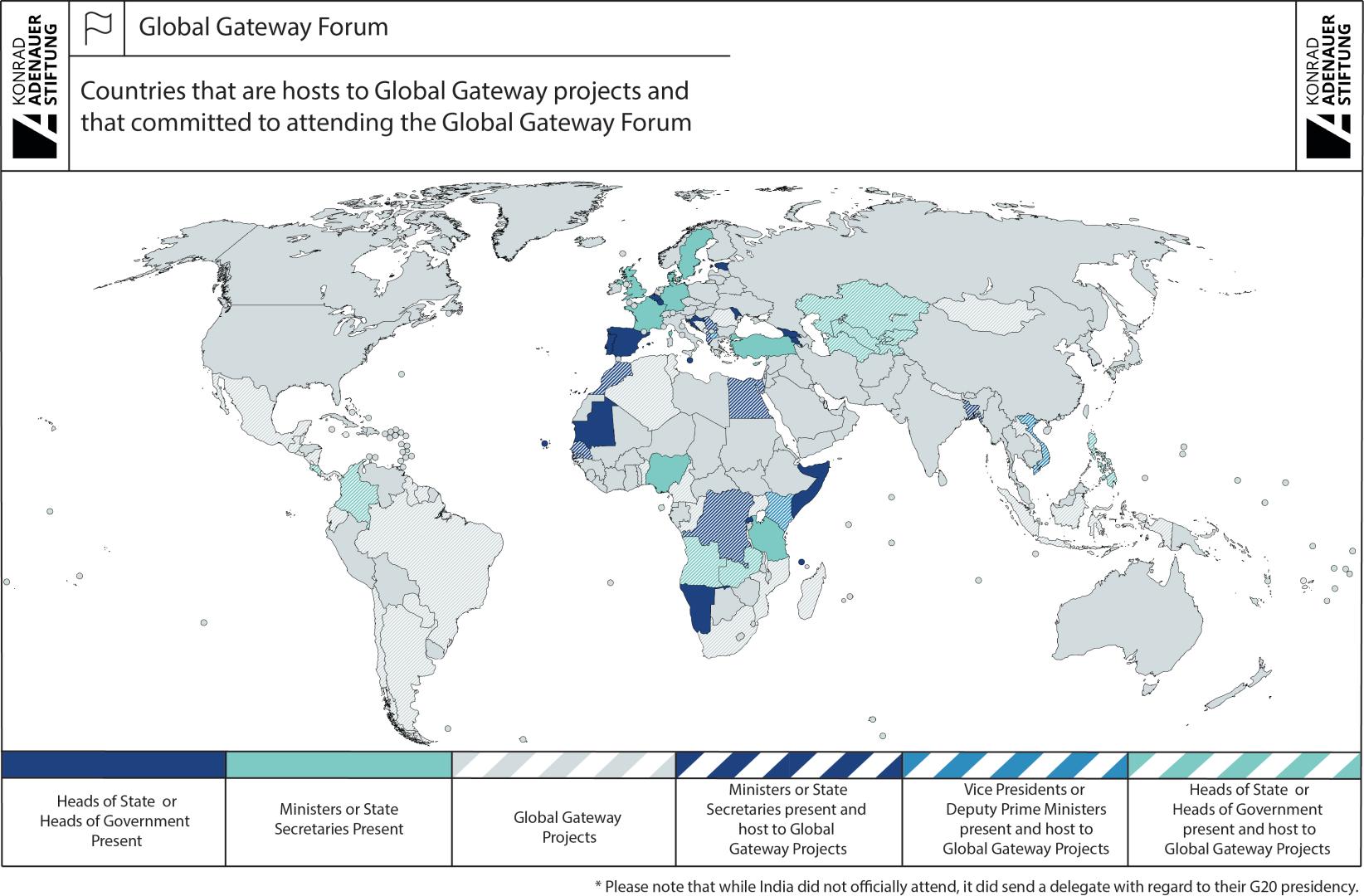The Global Gateway Forum, convened on October 25th and 26th in Brussels, brought together distinguished delegates from more than 40 nations. This gathering provided the European Union with a platform to showcase its Global Gateway strategy, introduced at the close of 2021, and to unveil specific projects.
Background
In December of 2021, the European Union unveiled its ambitious Global Gateway strategy with the primary objective of strengthening its partnerships with countries beyond the EU through collaborative infrastructure projects. A cornerstone of this strategy is the requirement that all projects adhere to stringent standards concerning democracy, the rule of law, transparency, and sustainability. The Global Gateway strategy is intentionally designed as a counter-model to China's Belt & Road Initiative (BRI). Not only do BRI projects often come paired with allegations of corruption, but they also often lead participating countries into a debt spiral that consequently deepens their reliance on China even further.[1] The Global Gateway initiative actively involves the private sector and focuses on investments in transportation, energy, climate, research, education, and digitization. Notably, these investments prioritize clean technologies and renewable energy sources. By 2027, the European Union has committed to investing approximately €300 billion, with half of this dedicated to the African continent. The initiative's target countries predominantly consist of middle- and low-income nations.
As of now, the European Union has committed a total of 66 billion euros to various projects, as reported by the European Commission. These funds originate from a variety of sources and instruments, including the NDICI (Neighborhood, Development Cooperation and International Cooperation Instrument) and support from the European Sustainable Development Fund Plus. Approximately half of this investment is expected to be secured through contributions from the European Bank for Reconstruction and Development (EBRD), the European Investment Bank (EIB), and EU member states.
The 2023 initiative has already identified 87 flagship projects spanning 54 countries across Africa, Latin America, Asia, the Western Balkans, and the European neighborhood.[2] These projects cover a wide spectrum of thematic areas, encompassing the green economy, healthcare, digitalization, infrastructure, and critical raw materials.[3] The scope and ambition of these projects vary significantly, ranging from smaller financial endeavors to substantial strategic ventures, such as the planned state-of-the-art Medusa undersea fiber optic cable connecting North Africa with southern EU countries.[4] Additionally, some projects are merely initiatives that have been reimagined or repurposed for the sake of the initiative.
Notably, the Global Gateway Forum held on October 25th and 26th served as a platform for both publicizing the initiative and announcing significant updates on new projects. It is worth highlighting that this event occurred just one week after the third Belt & Road Forum for International Cooperation organized by China.
Participating countries
A total of 16 heads of state and government from non-European nations were in attendance (please refer to the attached map for details). Additionally, numerous other countries were represented by deputy heads of state and government or their respective ministers and state secretaries. Some countries even sent multiple government representatives. Among the EU participants, seven heads of state and government were present, while a few EU countries, mainly from Central and Eastern Europe, and including Italy, were not represented by either a minister or a state secretary. Germany was represented by the State Secretary and Special Representative for International Climate Policy, Jennifer Morgan.
In total, 46 countries were represented, with a noteworthy concentration of countries from sub-Saharan Africa. In contrast, Latin American representation was relatively low, despite several Global Gateway projects located in the region. The absence of Brazil was particularly noteworthy, especially considering the upcoming G20 presidency and the recent expansion of the BRICS alliance. It's worth mentioning that several countries attending the summit are actively involved in China's Belt and Road Initiative (BRI). The participating non-European countries span a spectrum of political systems, including democracies, hybrid regimes, and deeply authoritarian states.
The event also saw the presence of heads of international organizations, including the European Investment Bank (EIB), the European Bank for Reconstruction and Development (EBRD), the World Bank, the World Health Organization, the World Trade Organization, and the Deputy Secretary-General of the United Nations.
Agenda and Outcomes of the Inaugural Global Gateway Forum 2023
During her opening speech, Commission President Ursula von der Leyen presented the initiative as a fresh perspective on extensive infrastructure projects in a challenging global landscape. Simultaneously, von der Leyen implied various drawbacks and shortcomings of the Belt and Road Initiative (BRI).
“For us is important that Global Gateway is about giving choices to countries – better choices. Because for many countries around the world, investment options are not only limited, but they all come with a lot of small print, and sometimes with a very high price. Sometimes it is the environment that pays the price. Sometimes it is workers, who are stripped of their rights. Sometimes foreign workers are brought in. And sometimes national sovereignty is compromised. No country should be faced with a situation in which the only option to finance its essential infrastructure is to sell its future.” [5]
President von der Leyen underscored Europe's commitment to the "Green Deal" during her opening speech, highlighting the EU's support for countries like India in addressing the challenges posed by climate change. This commitment was evident in the various climate-related projects in Latin America and Asia.[6] Alongside the announcements, several new projects were signed during the summit, ranging from the low tens of millions to the hundreds of millions.
In Southeast Asia, the Global Gateway Forum placed particular emphasis on Vietnam and the Philippines, with a focus on climate policy initiatives in both countries. For instance, Vietnam and the European Investment Bank (EIB) signed a memorandum of understanding to support the implementation of the Just Energy Transition Partnership (JETP) in Vietnam, committing to establish a EUR 500 million credit facility, primarily to back energy sector reforms.[7]
In the Philippines, a EUR 60 million financing agreement for the green economy took center stage. This program aims to assist the Western Pacific archipelago in sustainable economic reform, including the implementation of a circular economy to combat the impacts of the climate crisis. Earlier in the year, von der Leyen and Philippine President Ferdinand Marcos Jr. inked an agreement under the Global Gateway initiative, with a funding volume of EUR 466 million for green economy projects.[8]
In Central Asia, the signed projects mainly revolved around global trade. Notable developments included the memorandum of understanding for sustainable critical raw materials (CRM) in Uzbekistan and an agreement to support the WTO accession of Turkmenistan. In Tajikistan and Kyrgyzstan, the focus shifted to education and digital infrastructure projects. The EU also signed a partnership and cooperation agreement with Bangladesh, accompanied by agreements worth EUR 400 million with the European Investment Bank (EIB) for renewable energy projects aimed at helping the country meet its climate change targets.[9] [10]
Apart from Kenya, which received a €72 million EU contribution as part of the annual EU action plans for 2023 and 2024, the summit also witnessed the establishment of "strategic partnerships" on critical raw material supply chains with Angola, the Democratic Republic of Congo, and Zambia. Additionally, in collaboration with the USA, an expansion of the Lobito Corridor, strategically significant for regional trade, was agreed upon.[11]
One of the pivotal aspects of this initiative, as reiterated by President von der Leyen in her opening speech, is the emphasis on enhanced cooperation with African countries, particularly in the health sector. This includes support for local production of mRNA vaccines, an issue of great importance for many African nations.
Analysis
Critics have raised concerns about the lack of clear strategic direction for the "Global Gateway" initiative, questioning whether it is primarily a development-focused strategy or a geopolitical project. Despite repeated denials from high-ranking European Commission officials regarding the latter, the speeches, participating countries, and flagship projects showcased at the Global Gateway Forum leave little doubt that it has a significant geostrategic dimension. This has naturally raised high expectations for the initiative's outcomes.
However, the initiative has faced several obstacles that hindered its initial progress. By the end of 2021, the EU's financial framework for the period until 2027 had already been established, with a substantial amount of funds already being committed. Additionally, the unprovoked Russian invasion of Ukraine has diverted even more resources. Consequently, many of the Global Gateway initiatives are essentially existing projects rebranded under the Global Gateway banner. The investment amounts are not yet competitive with those of the Belt and Road Initiative (BRI). Moreover, the communication of the strategy to potential partners has faced challenges. For instance, although involving private partners is a central aspect of the strategy, the EU Commissioner for International Partnerships, Jutta Urpilainen, did not announce the formation of an advisory board with business representatives until September 2023. Furthermore, some crucial business players and associations learned about the initiative's details only at short notice through the forum itself.
The EU faces the intricate task of balancing multiple objectives. First, the strategy aims to offer a "cleaner" alternative to the BRI concerning governance, the rule of law, transparency, and sustainability while promoting democratic values globally. Second, it seeks to encompass projects of considerable scope and strategic significance. Third, it strives to complete strategic projects with as many key partners as possible, despite limited financial resources. Achieving these goals to the same extent presents a formidable challenge. A point of contention among Brussels stakeholders is the degree of democratic conditionality or accountability applied to project implementation.
Despite the various obstacles and initial hurdles, it would be premature to dismiss this initiative. There is an urgent and overdue need for a genuine alternative to the BRI, one that merits full support from the member states. In the words of David McAllister, the Chairman of the Foreign Affairs Committee in the European Parliament, "If not now, when?"[12]
For this initiative to gain momentum, it must be diligently pursued and provided with the necessary resources after a slow start. Additionally, defining its strategic orientation and the logic of its actions, whether geopolitical or developmental, is crucial. To evolve into a sustainable alternative to the BRI, it must become a key component of the next European Commission's agenda and hold a central position in the EU's next multiannual financial framework (MFF) starting in 2028.
[1]Study links 35 percent of Chinese Belt and Road Initiative projects to scandals involving corruption, environmental problems, labour violations - Business & Human Rights Resource Centre (business-humanrights.org), AidData | Banking on the Belt and Road: Insights from a new global dataset of 13,427 Chinese development projects
[2] Freihandelsabkommen – Zur Öffnung von Märkten (gtai.de)
[3] The flagship projects are listed here: Global Gateway 2023 Flagship projects - Infographics (europa.eu)
[4] https://international-partnerships.ec.europa.eu/policies/global-gateway/medusa-optical-fibre-cable_en
[5] Opening speech by the President: Global Gateway Forum (europa.eu)
[6] EC AV PORTAL (europa.eu)
[7] Team Europe and Vietnam (europa.eu)
[8] Global Gateway Forum: EU and Philippines sign €60 million Green Economy Programme (europa.eu)
[9] Global Gateway Forum: EU boosts employment in Tajikistan with €30 million in budget support (europa.eu)
[10] Global Gateway: EU and Bangladesh (europa.eu)
[11] This connects the resource-rich areas in northern Zambia and in Katanga (DR Congo) with the port of Lobito in Angola
[12] Global Gateway: If not now, when? – POLITICO
Topics
About this series
The Konrad-Adenauer-Stiftung is a political foundation. Our offices abroad are in charge of over 200 projects in more than 120 countries. The country reports offer current analyses, exclusive evaluations, background information and forecasts - provided by our international staff.





